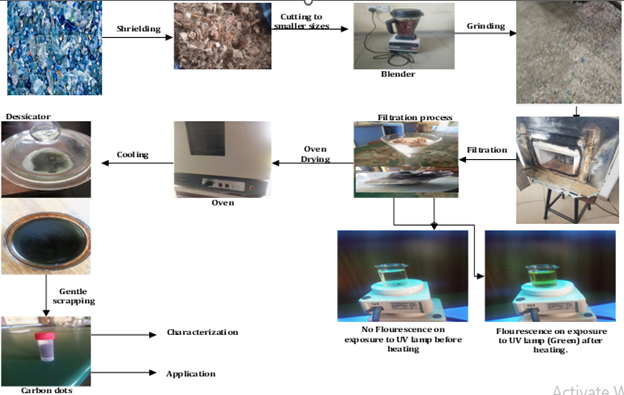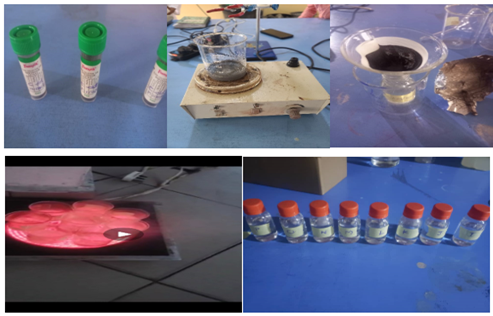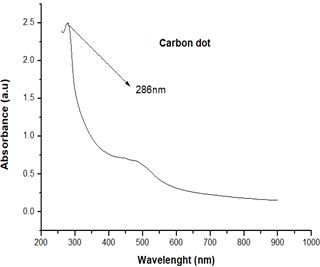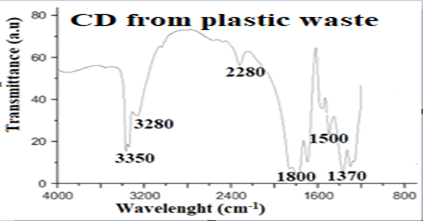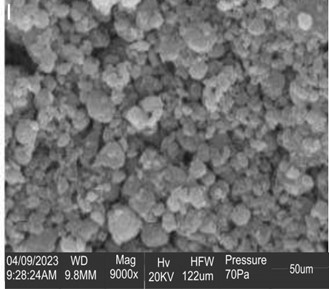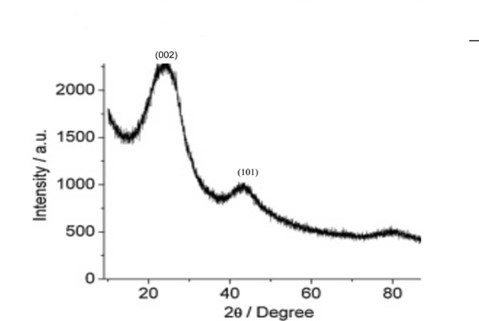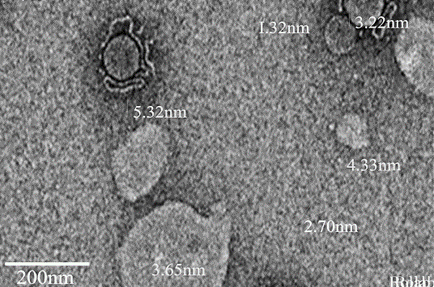Synthesis and Characterization of Carbon Dot from Plastic Waste for Remediation of Fe3+ in Wastewater.
- B. H. Akpeji
- P. O. Akusu
- M.C Emegha
- E.E Onyenue
- E.E Elemike
- 14-22
- Jun 27, 2024
- Chemistry
Synthesis and Characterization of Carbon Dot from Plastic Waste for Remediation of Fe3+ in Wastewater.
B. H. Akpeji1*, P. O. Akusu2, M.C Emegha1, E.E Onyenue1, E.E Elemike1
1Department of Chemistry, Federal University of Petroleum Resources, PMB 1221, Effurun, Delta State, Nigeria.
2Petroleum and Natural Gas Processing Department, Petroleum Training Institute, Effurun, Delta State, Nigeria.
*Corresponding Author
DOI: https://doi.org/10.51584/IJRIAS.2024.906002
Received: 15 May 2024; Revised: 23 May 2024; Accepted: 27 May 2024; Published: 27 June 2024
ABSTRACT
In this research, carbon dot was synthesized from a plastic waste materials. The prepared carbon dots was investigated for its reaction, structure, morphology and remediation of Fe3+ in industrial wastewater. The carbon dots (CDs) were characterized using the UV-Visible spectrophotometry, Fourier Transform Infrared Spectrophotometry (FTIR), Energy Dispersive Spectrometry (EDX), Powdered X-ray Diffractometry (PXRD), Scanning Electron Microscopy (SEM) and Transmission Electron Microscopy (TEM). UV-Visible spectra revealed that carbon dot showed maximum absorption peaks at 286nm. FTIR results of carbon dot showed reactive functional group –OH, ClO, C=O and C–O. The EDX results revealed the elemental composition with percentages of the elements in the materials. The SEM morphology of the synthesized carbon dot was spherical in shape. The average particle size of the nano-dot as characterized by TEM was 3.94nm. XRD spectra results showed that the carbon dot is an amorphose substance. Adsorption studies was carried out using the carbon dot to remediate Fe3+ from wastewater. Result showed that the carbon dot reduced the concentration of Fe3+ in the wastewater considering the parameters of contact time and adsorbent dosage.
Keywords: Carbon dot, wastewater, Remediation.
INTRODUCTION
Carbon dots (CDs) are new-generation carbon nanomaterials with a characteristic diameter size less than 10 nm. In recent days, CDs have gained a lot of attention among researchers because of their smallest size, tunable characteristics, low toxicity, biocompatibility and cheaply available precursors for synthesis (Bibekananda and Niranjan, 2013). With these intriguing characteristics, CDs have now emerged as a promising substitute for metal-based quantum dots, with applications in bioimaging and photocatalysis, while simultaneously opening up research avenues to resolve several environmental issues with their unique surface chemistry (Zheng et al., 2004; Elemike et al., 2021; Shen et al., 2018; Wang et al., 2020).
The contamination of drinking water is one of the major health concerns that are witnessed worldwide. Globally, 3 out of 10 people, or 2.1 billion people, lack access to safe and readily available water at home, and 6 out of 10 people, or 4.5 billion people, lack access to safely managed water (WHO and UNICEF 2017). Every year, waterborne infections claim millions of lives globally, with the majority of these deaths occurring in developing nations (Odonkor et al., 2020). Hence, the development of cost-effective and environment-friendly water disinfection technologies is the need of the hour. At this juncture, CDs, which have been reported to have antibacterial activity (Dong et al., 2020; Ghirardello et al., 2021) while demonstrating nontoxicity in mammalian systems and with a large opportunity of being synthesized from diverse waste biomasses (Chauhan et al., 2020) makes this as a good candidate for exploring their potential as a water disinfection agent.
Every day, a sizable amount of untreated wastewater from industry, agriculture, and homes is dumped into natural water bodies including lakes, rivers, and oceans. As a result, the pollution in these aquatic bodies is increasing metallic pollutants in the wastewater (Chauhan et al., 2020; Akoma et al., 2019). Since they are poisonous and non-biodegradable and are present in large quantities in both naturally occurring and artificially altered environments, heavy metals constitute a risk to public health predominantly on iron.
The use of carbon-based materials for heavy metal remediation has been practiced for a long time. Starting from biochar to activated carbon, carbon nanotubes, and graphene oxide several types of carbon-rich materials are continuously being developed for heavy metal remediation (Gusain et al., 2020). With the bulky nature of the activated carbon, high cost of synthesis, as well as regeneration issues, a gradual change towards nanomaterials, has been observed, among which carbon dots, are the newly added member of this adsorbent family. The carbon dots have been credited with the following properties of; large number of surface adsorption sites due to nano size, synthesis, as well as raw materials are generally inexpensive and green, as mostly hydrophilic, further functionalization is not required to work in an aqueous medium (Gusain et al., 2020).
Among the various wastes, the polymer waste biomass is considered a sustainable, cheap and alternative feedstock for the preparation of carbon dots (Chauhan et al., 2020). Also, the challenges of heavy metal poisoning caused by indiscriminate disposal of waste matter containing heavy metal into the water bodies has brought the reason for this research work to be looked, unto remediating this menace by the use of small carbon materials known as carbon dots. This will be a good eye opener and a fast way of solving these problems among the science communities, bringing safe to drinking water and increasing water quality.
The goal of this study is to find a solution to the problem of iron as heavy metal contamination in industrial wastewater. This contamination can be extremely dangerous, contaminating rivers, lakes, and groundwater, and leading to long-term health issues when consumed by humans. To address this issue, the study is exploring the use of carbon dot as an adsorbent material to remove iron from industrial wastewater. By researching the effectiveness of this approach, the study hopes to provide a potential solution for reducing the levels of iron metal pollutants in industrial effluents and protecting the environment and public health.
MATERIALS AND METHODS
Equipment
The equipment used in the synthesis of carbon dot are as follow as observed in the Chemistry Department of the Federal University of Petroleum Resources:
- chemical balance (JJ623BC),
- drying oven (LD-201-E vision scientific),
- heating mantle (HH-W420),
- UV-Visible spectrophotometer (Perkin Elmer Lambda 40),
- UV-lamp (CAMAG-30003),
- retort stand,
- magnetic stirrer (78-1),
- water deionizer (Elgacan B114),
- desiccator
- Plastic wastes
Chemicals and Reagents.
Distilled-deionized water would produced in the chemistry laboratory, Federal University of Petroleum Resources (FUPRE).
Methods
Synthesis of carbon dots from plastic waste using hydrothermal carbonization.
Following the description and contribution of Rifat et al., (2021) in the synthesis of carbon quantum dot, this carbon dot was synthesized using same description but with slight variations in the procedure used. The method of synthesis of carbon dots that would be described in this work is the hydrothermal carbonization method at 400oC for about 1hour 30minutes. About 500g of the plastic waste was carbonized in a murfle furnace at 1hour 30minutes. The solid carbon was removed after cooling and then pulverized using morta and pestle. The powdered carbon obtained was submerged into an empty container and 1000ml of distilled water was added. The mixture was allowed to boil in the furnace for about 2 hours at 4000C for excitation of molecules. The resulting mixture was filtered, and the filtrate was transferred into a conical flask and properly sealed with foil paper to make air-tight. The formation of the carbon dot showed green luminescence behaviour under the UV light with the use of the UV-lamp. The filtrate was centrifuged and residue into petri dishes and dried in an oven at 1050C. After drying, the carbon dots was deposited at the surface of the petri dishes which was gently scrapped and stored in sample bottle. The synthesized carbon dot was then characterized by instrumental analysis like the UV-Visible spectrophotometry, Fourier Transform Infrared Spectrophotometry (FTIR), Scanning Electron Microscopy (SEM), Transmission Electron Microscopy (TEM), X-ray Diffractometry (XRD) and Energy Dispersive X-ray techniques.
Figure 2.1: Process flow diagram for the synthesis of carbon dot from Plastic Waste
Characterization of the Carbon Dot as a Sorbent
The carbon dot was be characterized for UV-Visible spectrophotometry, Fourier Transform Infrared Spectrophotometry (FTIR), Scanning Electron Microscopy (SEM), Transmission Electron Microscopy (TEM), X-ray Diffractometry (XRD) and Energy Dispersive X-ray techniques. These characterizations explain the properties of the synthesized carbon dot and the quality assurance of the product for application in the removal of Fe3+ in water.
Adsorptive Treatment of Iron Metal in Effluent Water using Carbon Dot and Digestion Process
The experimental procedure employed in this research was drawn using the procedure previously reported by (Amin et al., 2018; Amuda et al., 2007) with some modifications. Batch adsorption for the removal of Iron as heavy metal (Fe3+) was conducted in 250ml of beakers by taking 70ml of wastewater. The experiments was carried out at room temperature, agitated at a rate of 200rpm for different parameters of mass of adsorbent and contact time. The adsorbent in this case is the carbon dot. After agitation, the residual adsorbent was removed by filtration using Whatman filter paper. Wet digestion was carried out on the samples using aqua regia of concentrated acids (HCl and HNO3) in ratio of 1:3. Digestion was carried out to breakdown complex matrices and extract or soluble metals from the sample.
The concentration of metal ion in the filtrates as well as control samples were determined by using Atomic Absorption Spectrometer of Schimadzu model number S145. The effect of adsorbent doses of (0.5g, 1.00g, 1.50g) at constant time of 1hour and contact time of (30minutes, 60minutes and 90 minutes) at constant dosage of 1.00g, were investigated by varying any one of the parameters and keeping the other parameters constant.
Figure 2.8: Batch adsorption and digestion of industrial wastewater
RESULT AND DISCUSSION
UV-Visible Spectrophotometer
A Perkin Elmer Lambda 40 UV-visible spectrometer was used to monitor the synthesis and progress of the carbon dot synthesized from plastic waste as shown in figure 3.1.
Figure 3.1: UV-Visible Spectrum of CD
Figure 3.1 reflects the UV-Visible spectrum of Carbon quantum dots made from plastic waste showed that the carbon quantum dot absorbed at 286nm which is in accordance with reports from literature Rifat et al., (2021). Carbon dots are generally known to exhibit broad absorption spectra that extend from the ultraviolet to visible range. This result corresponds to the UV and blue light regions of the electromagnetic spectrum reported by (Bibekananda and Niranjan, 2013).
Fourier Transform Infra-Red (FTIR) Spectrophotometer
Figure 3.2 is the FTIR result which revealed the chemical properties of the synthesized carbon dot, which are determined for the presence of the functional groups present on the surface of the nanoparticles. The FTIR spectrophotometry of model Nicolet iS10 FT-IR Spectrometer is used for this analysis which range from ranges from 4000 to 450 wave number.
Figure 3.2: FTIR Spectrum for CD from plastic waste
Figure 3.2 described the FTIR spectrum of the carbon dots which showed obvious absorption bands within the range of 800-4000cm-1. In this particular spectrum, stretching frequencies at 3350, 2280, 1800, 1500, 1370 cm-1 were observed, indicating the presence of –OH, ClO, C=O and C–O respectively. The presence of these functional groups (-OH and C=O) suggest that the synthesized carbon dots have excellent water solubility. The presence of various chemical functional groups in in this carbon dot gives idea of its potency in heavy metal remediation as it will be able to form bond with metals thereby reducing their concentration in the water sample.
Scanning Electron Microscope
Figure 3.3 depicts the Scanning Electron Microscope (SEM) micrographs of the Carbon dot (C.dot). The scanning electron microscope (SEM) is a highly specialized instrument that captures images of a specific sample by utilizing a focused electron beam to scan its surface.
Figure 3.3: SEM Micrograph for CD from plastic waste
Figure 3.3 reveals the SEM micrograph for carbon dot with a spherical shape in every side for adsorption molecules onto the surface of the carbon dot. The porous surface seen in the micrograph explains their high reactivity in the adsorption of molecules like heavy metals. Past research works of (Junjun et al., 2020) had explained similar observations with respect to its morphology and significance in application.
Powder X-ray Diffraction Techniques
Powder X-ray diffraction techniques (PXRD). The spectral information helps to determine the state of crystallinity and non-crystallinity of the carbon dot with diffraction peaks obtained accordingly. The X-ray diffraction (XRD) technique is commonly used to determine the crystalline structure and degree of crystallinity of a substance. By examining these characteristics of XRD peaks, such as peak sharpness, number, intensity, positions, and spacing, one can assess the state of crystallinity of a substance. Crystalline materials typically exhibit well-defined, sharp peaks with multiple distinct peaks and high intensity, indicating a higher degree of crystallinity. In contrast, amorphous materials or substances with lower crystallinity may exhibit broad or diffuse peaks with lower intensity.
Figure 3.4: XRD Spectrum for CD from plastic waste
Figure 3.4 revealed the XRD spectrum of carbon dot synthesized from plastic waste. The pattern showed peaks at 2theta index of 22.853o and 43.324o corresponding to the (002) and (101) respectively. The broadness, non-sharpness and low intensity of the peaks confirms the non-crystallinity of the carbon dots. Different observation was noticed by Rifat et al., (2021) in their past work where peak of 21.7o was noticed which is equivalent to (002) in the 2theta plane with broad peaks all over the spectra. This explains the non-crystalline state of the synthesized carbon dot. This could also help improve its adsorption of metals from solutions.
Transmission Electron Microscope (TEM)
Using a TEM model JEOL2100 instrument fitted with a LaB 6 electron gun, the morphological characterization including shape and particle size of the biosynthesized nanomaterials was done as shown in figure 3.4. This is an important instrumental technique that justify the synthesis of nanoparticles if it is within the accepted range of 1-100nm. The significance is to reveal the particle size of the nanoparticles and nanocomposites within the nanometer range.
Figure 3.5: TEM Micrograph for CD from plastic waste
The nanomaterials in Figure 3.5 revealed the TEM micrograph of Carbon dot. The micrographs showed sphericity and well dispersed, separated and without agglomerations, which gives an idea on the successful synthesis of the carbon dot. The particle size of the synthesized carbon dot from groundnut shells have been inscribed on the micrographs accordingly. The average particle size is therefore 3.94nm for the synthesized carbon dot, which is between the nano-range of 1-10nm. This actually showed the successful synthesis of the carbon dot owing to the particle size. The particle size of the carbon dot showed that it has a very high surface area which explains its application in the adsorption of heavy metals of high molecular weight (Tratnyek et al., 2006).
Adsorption Experiment
Heavy metals in industrial wastewater
Characterization of the industrial effluent was successfully conducted using Atomic Absorption Spectrophotometer (AAS) and the results are presented in table 3.1. This was done in order to have information on the heavy metals that are more concentrated so as to decide on the type to remediate from the wastewater during the treatment process.
Table 3.1: Concentration of Iron III ion (Fe3+) in wastewater on Effect of Dosage at Constant Time (60 minutes)
| Sample | Concentration (mg/L) | NESREA (2022) mg/L | WHO (2003) mg/L |
| I = 0.5g/70ml | 0.510 | 0.3 | 0.3 |
| J = 1.0g/70ml | 0.498 | 0.3 | 3.0 |
| K = 1.5g/70ml | 0.500 | 0.3 | 3.0 |
Table 3.2: Concentration of Iron III ion (Fe3+) in wastewater on Effect of Time at Constant Dosage (1.00g)
| Sample | Concentration (mg/L) | NESREA (2022) mg/L | WHO (2003) mg/L |
| L = 30min/70ml | 0.501 | 0.3 | 3.0 |
| M = 60 min/70ml | 0.456 | 0.3 | 3.0 |
| N = 90min/70ml | 0.221 | 0.3 | 3.0 |
| O = Control | 1.808 | 0.3 | 3.0 |
| P = Blank | ND | 0.3 | 3.0 |
Table 3.1 and 3.2 showed the Concentration of iron III ion (Fe3+) in wastewater on Effect of Dosage at Constant Time (1hour) and Concentration of iron III ion (Fe3+) in wastewater on Effect of Time at Constant Dosage (1.00g). It was observed that the concentration of Fe3+ appeared far below the Nigeria Environmental standard and Regulations Enforcement Agency (NESREA) and World Health Organization (WHO) standard. Result also showed that as the dosage size increased, there was a remarkable reduce in the concentration of iron. Also, increase in the contact time between the adsorbent and the lead in the waste water resulted in the reduction of iron III ion in the wastewater. Meanwhile the control has the highest concentration of lead and could not be detected in the blank which is the deionized water.
CONCLUSION
From research, different adsorbent mediums have been used to reduce heavy metals present in waste water and result accomplished. There is hope to obtaining a better result owing to the type of adsorbent that is used in this work and its efficiency in remediation process because of its high surface area. The work has shown successful synthesis of carbon dot. The carbon dot was characterized for UV, FTIR, SEM, TEM and EDX which showed complete synthesis. The carbon dot was tested in the removal of iron III ion in industrial wastwater and result revealed their potential in the remediation process.
REFERENCES
- Amin, M. T., Alazba, A. A., & Shafiq, M. (2018). Removal of Copper and Lead using Banana Biochar in Batch Adsorption Systems: Isotherms and Kinetic Studies. Arabian Journal for Science and Engineering, 43(11), 5711–5722. https://doi.org/10.1007/s13369-017-2934-z.
- Amuda, O. S., Giwa, A. A., & Bello, I. A. (2007). Removal of heavy metal from industrial wastewater using modified activated coconut shell carbon. 36, 174–181. https://doi.org/10.1016/j.bej.2007.02.013.
- Akoma, A. O., Jacobs, J. O., Ajai, A. I., & Orire, A. M. (2019). Heavy metal concentrations in water from fishing sites in the federal capital territory and four selected states in the north. FUW Trends in Science & Technology Journal, 3(2A), 444–449.
- Bibekananda D.E and Niranjan K. (2013). A green and facile approach for the synthesis of water soluble fluorescent carbon dots from banana juice. Journal of the Royal Society of Chemistry. DOI: 10.1039/c3ra00088e. Vol 3, page 8286–8290.
- Bustillo-Lecompte, C., Mehrab Mehrvar. (2017). Slaughterhouse Wastewater: Treatment, Management and Resource Recovery, Physico-Chemical Wastewater Treatment and Resource Recovery, Intechopen, 2(5), 101-117; DOI: 10.5772/65499.
- Duffus JH (2010). Heavy metals-a meaningless term? Pure Appl Chem. ;74(5):793–807
- Chauhan P., Dogra S., Chaudhary S., Kumar R. (2020). Usage of coconut coir for sustainable production of high-valued carbon dots with discriminatory sensing aptitude toward metal ions. Today Chem.2020, 16, 100247.
- Dong, X., Liang W., Meziani M.J., Sun Y.P., Yang L. (2020. Carbon dots as potent antimicrobial agents. Theranostics2020, 10, 671–686.
- Elemike E.E, Adeyemi J., Onwudiwe D.C., Wei L., Oyedeji A.O (2022). The Future of energy materials; A case of Mxenes-carbon dots Journal of Energy storage. 50(104711).
- Ghirardello, M.; Ramos-Soriano, J.; Galan, M.C. (2021). Carbon dots as an emergent class of antimicrobial agents. Nano Mater.2021, 11, 1877.
- Gusain R., Kumar N., Ray S.S (2020). Recent advances in carbon nanomaterial-based adsorbents for water purification.Coord. Chem. Rev., 405 (2020), Article 213111.
- Junjun L, Rui L, Bai Y. (2020). Carbon dots; A new type of carbon-based Nanomaterial with wide Applications. ACS Central Science. 6(12), 2179-2195
- Mishra, V.; Patil, A.; Thakur, S.; Kesharwani, P. Carbon dots: Emerging theranostic nanoarchitectures. Drug Discov. Today2018, 23, 1219–1232.
- Odonkor, S.T.; Mahami, T. (2020). Escherichia colias a tool for disease risk assessment of drinking water sources. J. Microbiol. 2020, 2020, 2534130.
- Okafor J.O, Aneke N.A.G, (2006). Characterization of Adsorbents for the purification of coca-cola effluent. Proceedings of the Nigerian Society of Chemical Engineers, 31st Annual Conference. 22 – 24.
- Rifat Hasan Md, Nepu Saha, Thomas Quaid and Toufiq Reza (2021). Formation of Carbon Quantum Dots via Hydrothermal Carbonization: Investigate the Effect of Precursors. Energies MDPI, Vol 14, 986. https://doi.org/10.3390/en14040986.
- Shen, C.L.; Zang, J.H.; Lou, Q.; Su, L.X.; Li, Z.; Liu, Z.Y.; Dong, L.; Shan, C.X. (2018). In-situ embedding of carbon dots in a trisodium citrate crystal matrix for tunable solid-state fluorescence. Carbon2018, 136, 359–368.
- Zheng, X.; Chen, G.; Li, Z.; Deng, S.; Xu, N.(2004). Quantum-mechanical investigation of field-emission mechanism of a micrometer-long single-walled carbon nanotube. Rev. Lett.2004, 92, 106803.
- Wang, L.; Li, W.; Yin, L.; Liu, Y.; Guo, H.; Lai, J.; Han, Y.; Li, G.; Li, M.; Zhang, J. (2020). Full-color fluorescent carbon quantum dots. Adv.2020, 6, eabb6772.
- Ye H.G., Lu X., Cheng R., Guo J., Li H., Wang C.F., Chen S. (2021). Mild bottom-up synthesis of carbon dots with temperature-dependent fluorescence. J. Lumin., 238 (2021), Article 118311.

